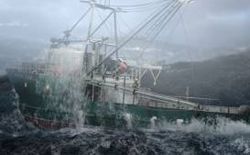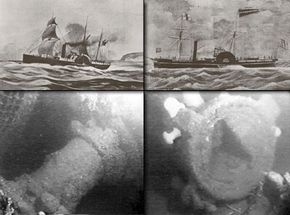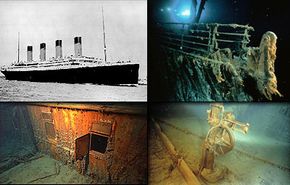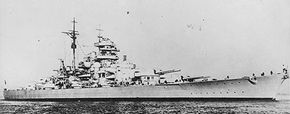Probably the grandest naval battle of World War II took place in 1941 and ended with the sinking of the German battleship Bismarck. She was a massive ship, about 17 stories tall and 300 yards (275 meters) long, and was one of the fastest (30 knots) and most heavily armored warships of her time. On her maiden voyage, she ended up in an epic, eight-day cat-and-mouse chase across the Atlantic involving two German ships and at least six British ones.
In the first major confrontation at Denmark Strait, the Bismarck and her sister ship destroyed the British ship HMS Hood (the largest battle cruiser in the world at the time). Their 203-mm shells struck the Hood and blew up the explosives on deck, and their 380-mm shells blew right threw the deck and reached the ammunition below. The Hood was a total loss, and almost 1,400 sailors died. Also at Denmark Strait, the German ships crippled the HMS Prince of Wales, but the Prince of Wales hit Bismarck a few times, too, which would haunt the German ship and ultimately be her downfall. The Prince of Wales struck her engine room, taking out two boilers, and ruptured the fuel tanks in the bow. The Bismarck no longer had enough fuel to get back to Germany, and her top speed had dropped to 28 knots. Bismarck's Admiral Lutjens changed course and headed to the nearest German-occupied French port.
On her way to safe harbor for repairs, the Bismarck took air fire from British torpedo planes, but none of the torpedoes got through her armor. After some evasive maneuvering, Bismarck escaped the British ships, and Admiral Lutjens then took the chance of sending a message to Berlin about the battle and her status. But the message was too long -- almost 30 minutes. British ships picked it up and pinpointed Bismarck's location. They resumed pursuit and caught up with her off the coast of Ireland.
Bismarck took heavy fire from both air and sea in what would turn out to be her final battle. In total, she took 400 hits from British battleships and at least 12 hits by torpedo planes. She was crippled, but she still wasn't sinking. It was the German sailors onboard who sunk the ship when it was clear they could no longer fight or escape. Bismarck sunk to the bottom of the Atlantic with most of her crew, including Admiral Lutjens. Of the 2,200 German sailors onboard, only 115 survived the wreck. In 1989, a crew led by Dr. Robert Ballard, who also discovered the wreck of the Titanic, found the Bismarck under 15,000 feet of water just south of Cork, Ireland.






